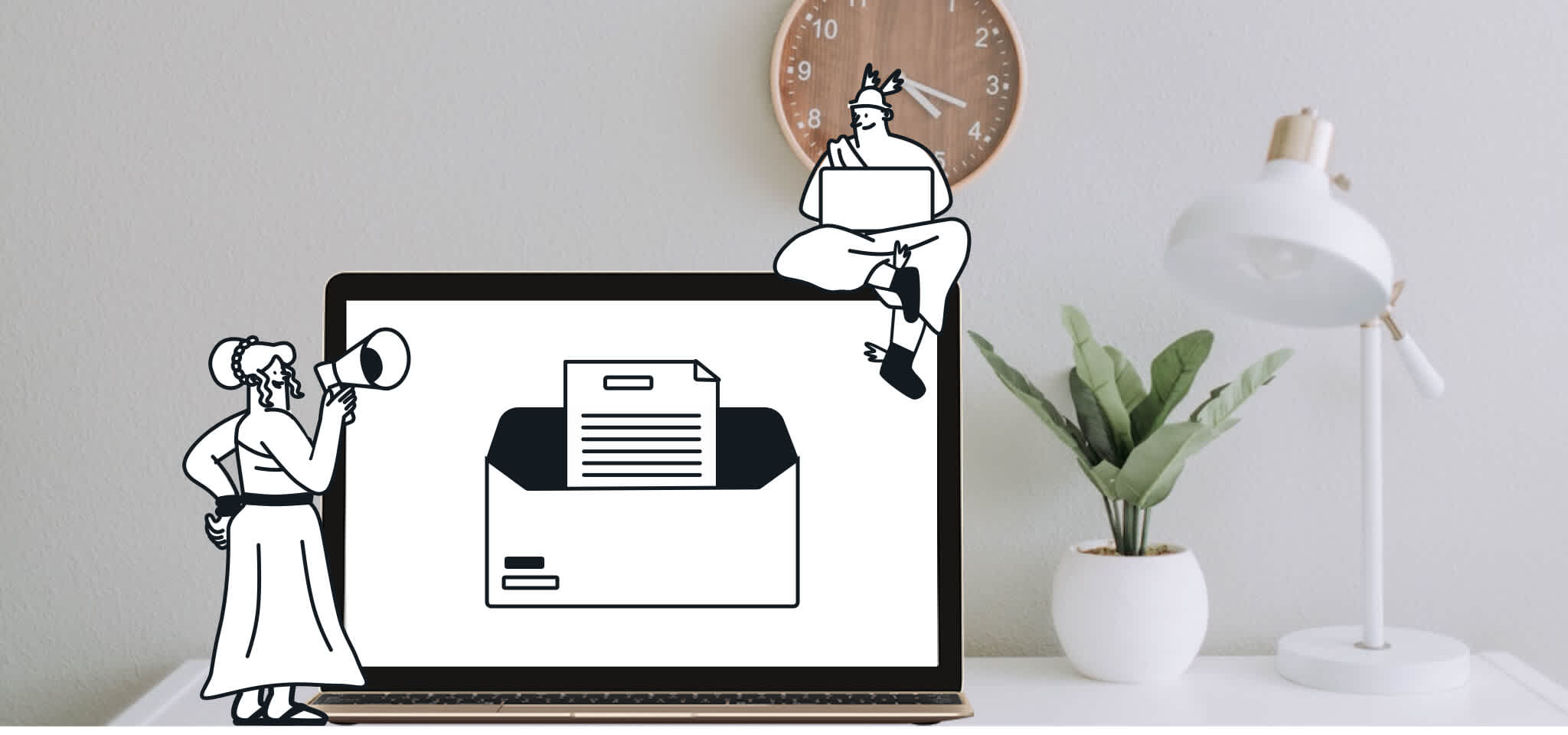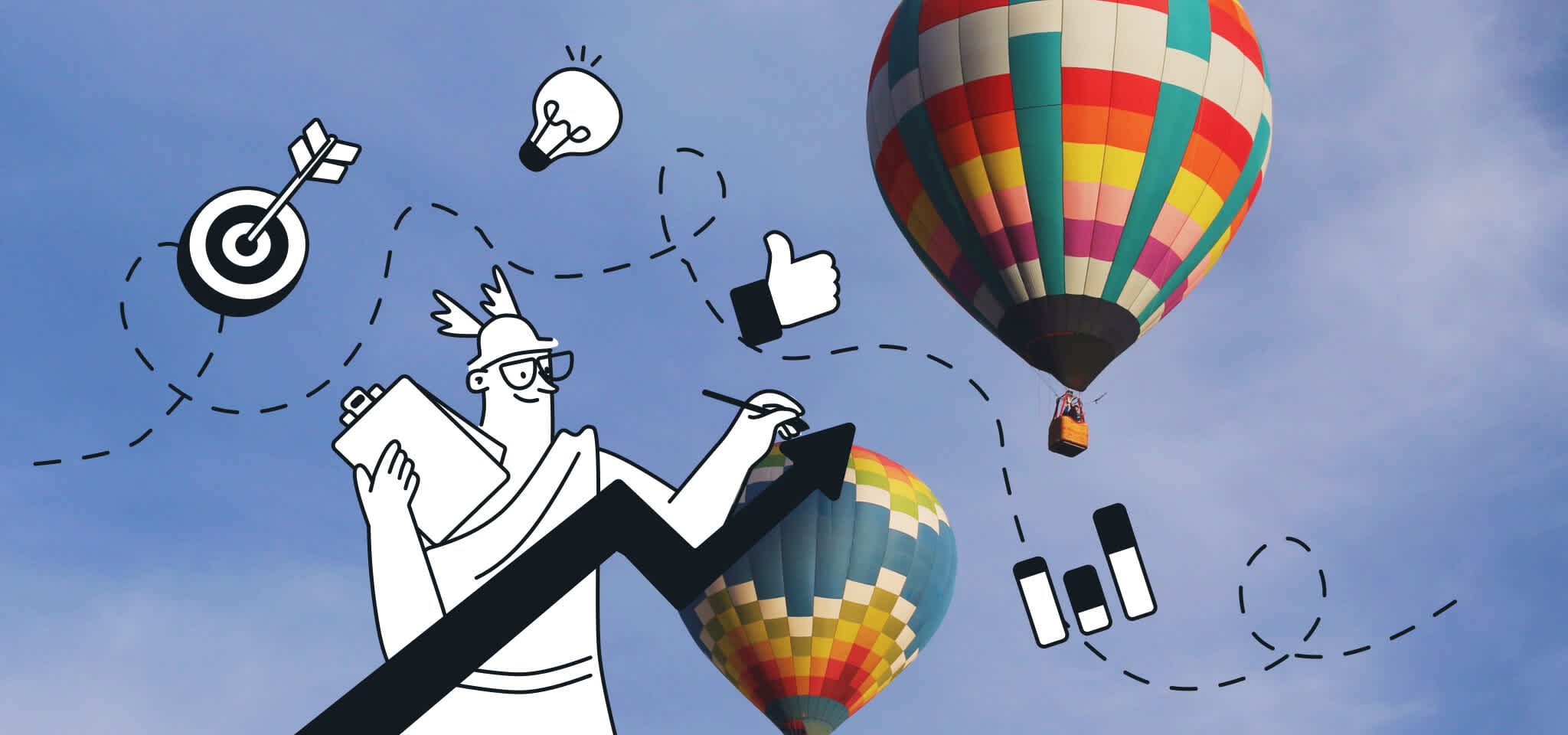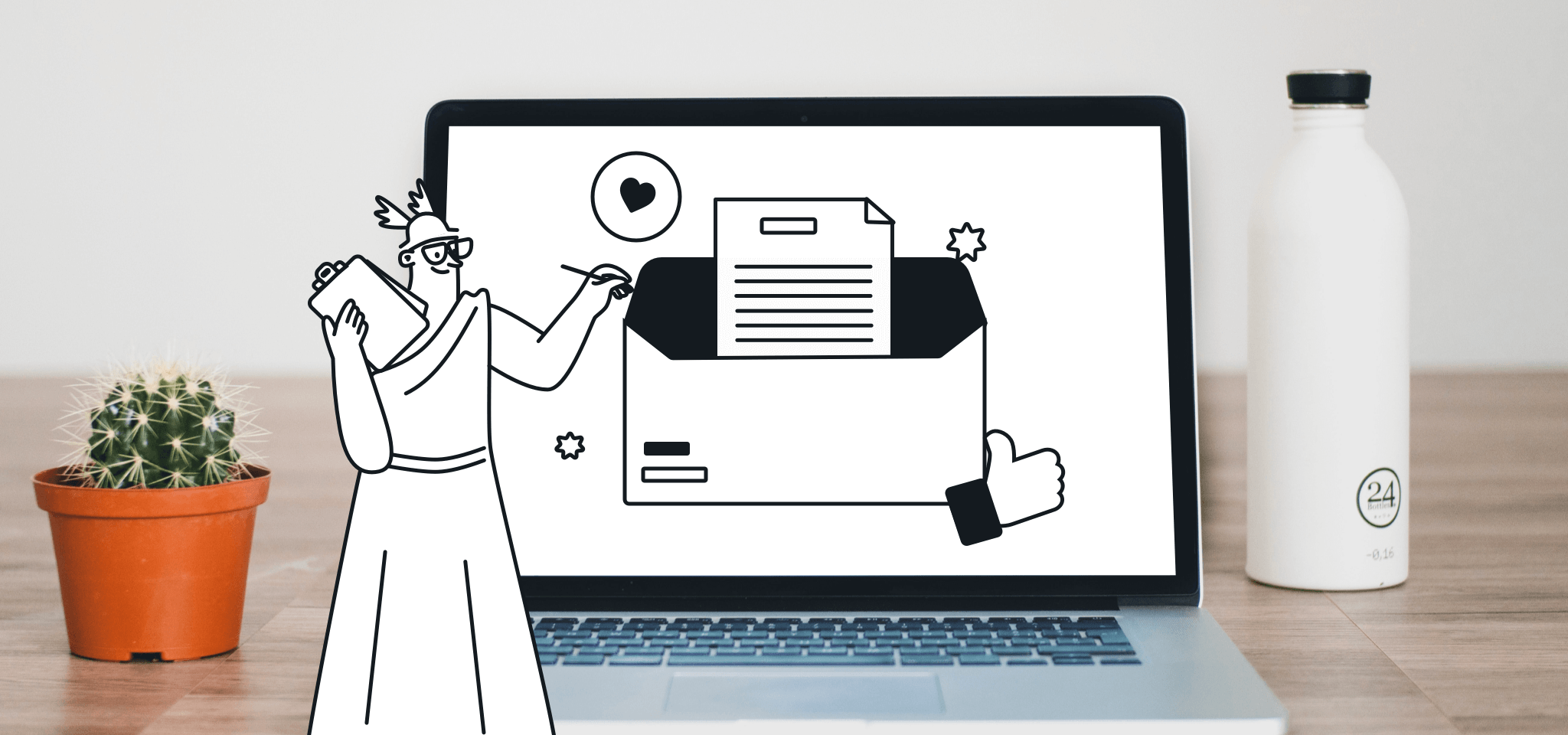Email best practices
The ultimate guide to high-converting email copywriting
Struggling to write copy that converts? Email Camp speaker and hilarious copywriter Lianna Patch showed us how it’s done in her signature style during Email Camp 2022. Now, we’ve pulled her best tips and examples and turned them into a post that will help you write high-performing email copy.

PUBLISHED ON
Writing copy for email campaigns can sometimes leave us frozen like a deer in headlights. How many times has your mind gone blank when trying to write perfectly converting copy?
Lucky for us, the whimsical copywriter Lianna Patch joined us for last year’s Email Camp: Road Trip Edition. Lianna is the “Head Puncher” at Punchline Conversion Copywriting, where she writes emails for SaaS and ecommerce companies.
In this post, we’ll cover all the juicy email copywriting tips and examples from her presentation (below) as well as some common mistakes to avoid.
Table of content
Pull copy directly from customer research
Lighten up a bit
Be specific with call-to-actions
Find “copy-tunities”
The pre-emptive objection-killer
The personal return helper
The dreaded wall of text
The “we-we” problem
Sentences trying too hard
Clichés and umbrella phrases
How to write emails that convert
Perhaps an unsung hero, email copy is an essential element in driving conversions for your marketing campaigns. It’s an art form that requires fine tuning to really hit the mark and speak to your audience. Lianna distilled all her experience down into four methods to drive up engagement in emails. We’ll show you how to pull directly from customer research, lighten up a bit, find "copy-tunities", and be more specific with your calls-to-action.
Pull copy directly from customer research
Putting pen to paper is difficult when you haven’t done it in a while, especially after a vacation when your brain feels like cobwebs. If only your customers could just write their own copy…
Chances are, you already have a goldmine of great copy, you just need to dig it up. One great place to look is customer feedback, such as reviews, support chat transcripts, and surveys. This can give you insight into the phrases and language that connect with your audience. Incorporating that language into your headlines and calls-to-action can help make your message more effective.
“You should pull your copy and messaging directly from your customer research. So anywhere that your customer has a chance to communicate with you, like one-on-one, open-ended, qualitative feedback. That is a goldmine for what they need to hear from you, points you’re not getting across, and actual verbatim phrases that you can swipe.”
Lianna Patch, Head Puncher at Punchline Conversion Copywriting
Here are a few sources of customer feedback you can leverage:
Reviews
Support chat transcripts
Chat transcripts with customer support team
Surveys
So how do we use all this raw data? Firstly, you should find patterns in the customer sentiment to see what they really love about your product. Next, create a table (below) and pluck phrases out to use in headlines and calls-to-action.
Quote | Message |
|---|---|
Quote | |
We slept on it for a week and my body has been transformed! I have noticed my lower back pain has diminished and my body has never felt so good. | Back neck pain lessened |
Message | |
I actually dream now, and they are happy dreams. I love that the bed doesn’t move when two people sleep on the bed. | No motion transfer |
I didn�’t believe in ghosts but now I do | Skeptics are convinced |
I literally want to be buried on top of it! | ... |
“When you use people’s words back at them, they feel like magic is happening.”
Lianna Patch, Head Puncher at Punchline Conversion Copywriting
Lighten up a bit
With the advent of AI, much of what we’ll soon be reading might be generated by a lifeless algorithm. Therefore, it’s never been as important for your brand to have an unmistakable voice and identity. Subscribers should see your subject line and be able to immediately recognize your welcoming style.
A great way to show your human side is to incorporate humor. Using comedy is a rare but potent form of copywriting, but it requires an element of risk for both the writer and the brand. Before you start googling “what are the best knock-knock jokes?”, think about common problems you share with your customer. You don’t need to become a stand-up comedian – just throw in some light-hearted quips to ease the reader and build trust.
“We want to be talked to as humans, we want to be conversational, we want to be friendly. You’re not going to lose any brand trust because you speak to them on a human level.”
Lianna Patch, Head Puncher at Punchline Conversion Copywriting
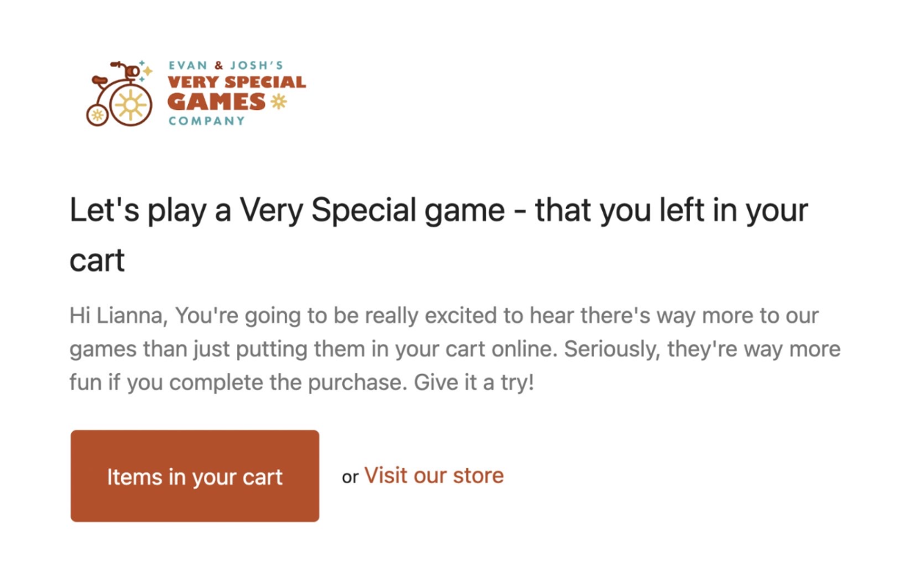
If you’re having fun, chances are your readers will be too.
Be specific with call-to-actions
Clichés have become so…cliché. While there’s nothing wrong with a call-to-action (CTA) that says “Learn More” or “Shop Now”, there’s everything right about getting creative. It ties in with the use of humor, too, as CTAs can present an opportunity to lighten up a bit. But like anything, there’s a fine balance you need to strike between being edgy and confusing your audience.
There are several approaches. You could go for the “curiosity gap” and be mysterious about the link within the button, like Lush’s Halloween CTA, “Summon The New.” Or you could try some delightful quips to lighten the mood, as seen in our newsletter below. But if your brand voice is limited, you can simply be more specific about where you’re sending your readers. For example, instead of “Visit Shop”, you could say “Browse T-shirts.”
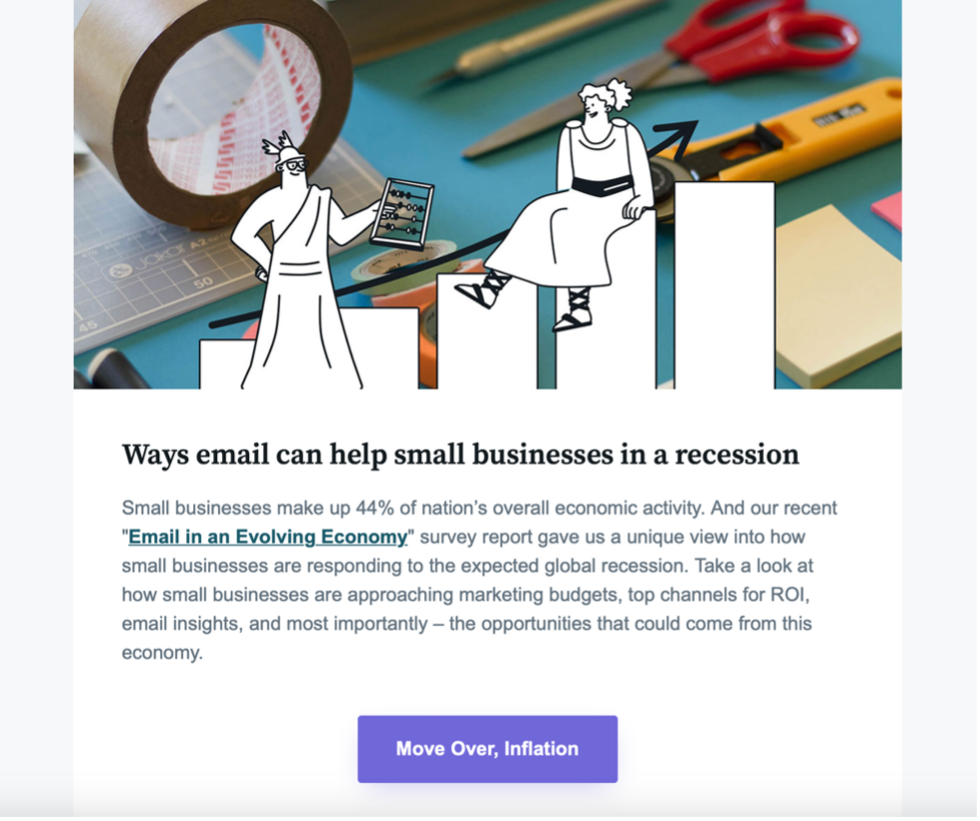
Our wonderful email marketer Julia always brings the smiles.
Find “copy-tunities”
Templates and transactional emails save us a lot of time, but they often get forgotten about. Plus, we can also fall into the trap of over-formalizing some areas of our email copy. Within all these blind spots, there are what Lianna calls “copy-tunities.” These are little nuggets of email text where we can squeeze out some extra juice.
Some great copy-tunities can be found in:
Email footers
Unsubscribe pages
Transactional emails
Photo captions
You’ve probably seen a few unsubscribe pages make a last-ditch attempt to keep users onside. There have been a few “It’s not you, it’s me” break-up parodies around where brands throw out all their self-imposed copywriting rules.
You don’t have to wait until your subscribers leave to bust out some truly original material. Carry out a quick email audit and find those “copy-tunities” to inject some copy magic.
Original email ideas to increase engagement
The full potential of email is still an untapped well and, although it sometimes feels like it’s all been done before, there are still plenty of ways to come up with something original. In her Email Camp session, Lianna shared some of her out-the-box customer engagement emails that “virtually no one is sending.” Give them a go, you might just boost the lifetime value of your customer base.
The pre-emptive objection-killer
We all know about the transactional email and the post-delivery email, but what about emails between order and delivery? Managing customer expectations can be one of the best ways to kill any objections before they flare up.
Lianna’s example below shows an email series she created for a client that sells coffee beans. By educating customers on how to brew coffee the right way, their lifetime value was boosted by 150% – not too bad at all.
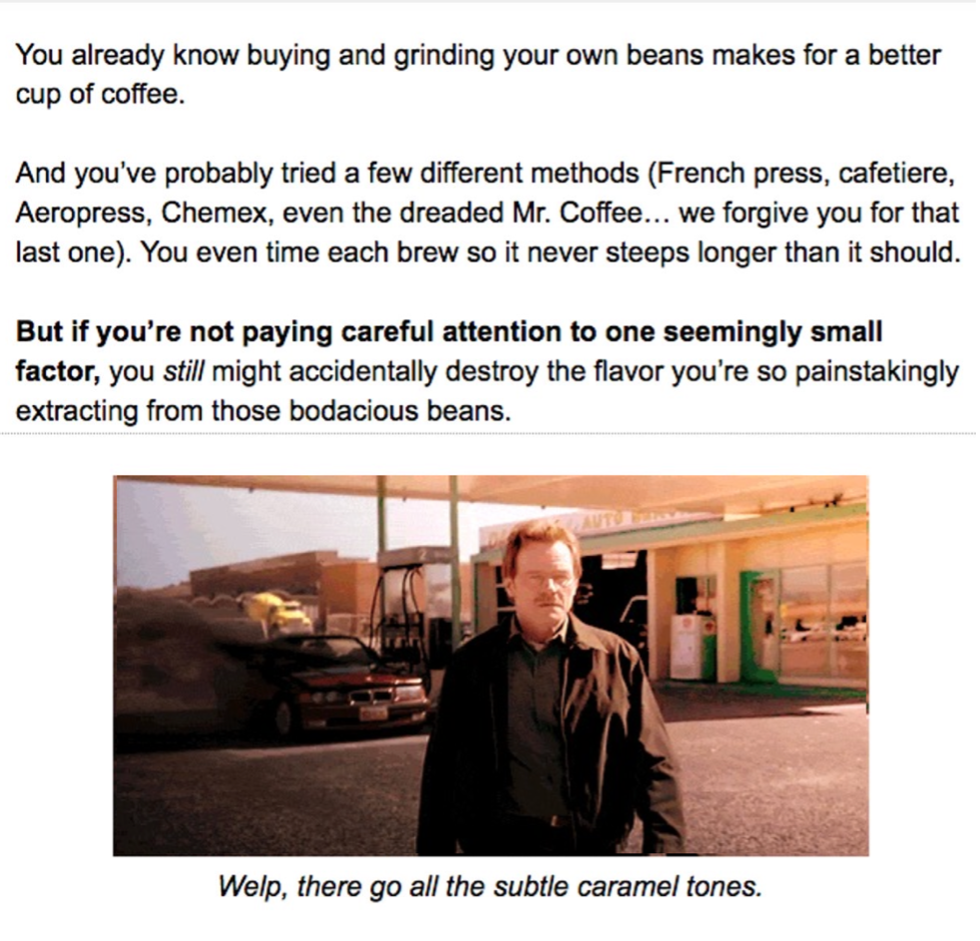
Some of Lianna’s client work for a coffee mail order company.
With this approach, you can reduce returns by taking away some of the mistakes your customers often report running into when first opening or using your product. The best news? This kind of email cadence not only has practical value, but also shows you’re thinking about them.
The personal return helper
It’s so often that we’re inundated with information before ordering something, only to be abandoned after the receipt comes through. Whether it’s a physical product or a service you’re offering, customers should feel like they’re looked after post-sale.
For example, when a customer asks for a return, they are often sent a transactional email outlining a Returns policy. With the power of email, you can become a personal return helper, using personalized fields to make the experience more authentic. Not only does this improve the level of customer service, but it’s a chance to request qualitative feedback that you can paraphrase in your marketing efforts.
Check out this example Lianna shared during her Email Camp session:
Hi Lianna,
This is Liz from the Styling Team at Mott & Bow. I wanted to reach out personally regarding order #0161F33F.
I noticed you requested to return the Slim Boyfriend - Benson - Light Blue jeans because the color wasn't what you expected. I want to help you find the perfect pair of jeans. Were you expecting a lighter or darker color? I ask because I want to help you get the right product in your hands.
Looking forward to your thoughts,
Liz
Styling Team
Mott & Bow
There are various ways to support customers along their journey with your brand, including:
Send a receipt with personalized recommendations.
Check in and ask for feedback.
Offer a coupon towards their next purchase.
Follow up when they’re running low.
All of these ideas help make your brand more personable and strengthen the relationship with your customers, increasing your chances of driving a repeat purchase and increasing brand loyalty.
Common copy mistakes to avoid
You may not be the next Shakespeare of email copywriting (yet), but you can at least avoid being the court jester. Before sending or automating your next email campaign, check that you’re not committing one of Lianna’s four common mistakes.
The dreaded wall of text
Sometimes it’s the case that good copywriters are bad designers or vice-versa. This could explain why the dreaded wall of text keeps showing up in our inboxes time and time again.
Why is this a problem? Walls of text can make it difficult for readers to navigate, retain and focus on the important information, causing them to lose interest or skip over key points. It’s especially hard for readers who like to scan content to understand what’s going on, which decreases your message's reach.
Luckily this is a pretty easy fix:
Create sections or add headers.
Use bullets for a series of items (most important first).
Use selective bolding.
Break paragraphs after two sentences.
Add images, emojis, or GIFs.
Information overload isn’t exclusive to text, it also makes its way into marketing imagery. Designers wince when they see images with scattered messaging plastered all over collateral. The bullet points above also apply to images.

Too many offers confuse readers
The “we-we” problem
Customer service emails are supposed to be about the customer, so it’s strange how many companies talk about…their company. The overuse of the first person “I, we, my” will make customers feel like they are not being recognized in a conversation.
“Go through your copy and see how many times you say “I, we, us, our” and can you flip at least 50-60% of those into second person? Probably.”
Lianna Patch, Head Puncher at Punchline Conversion Copywriting
The simple fix is to include more second person pronouns like “you, your, and yours.” Address the customer directly and relay what they’ve told you back to them, so they know you’re listening.
Sentences trying too hard
You’ve seen the dreaded wall of text – here we have the dreaded sentence of text. This is when you pack too much information into one sentence, it can be tough for the reader to follow. It's like when someone tries to tell a really long and winding story and can't seem to get to the point.
It's okay, we’re all guilty of this at one time or another.
Ideally, you want writing that is short and sharp with one point per sentence. Keep the reader on their toes and mix up your writing flow with short, medium, and long sentences. Turn it into a dance – if it’s fun to write, chances are it will be fun to read.
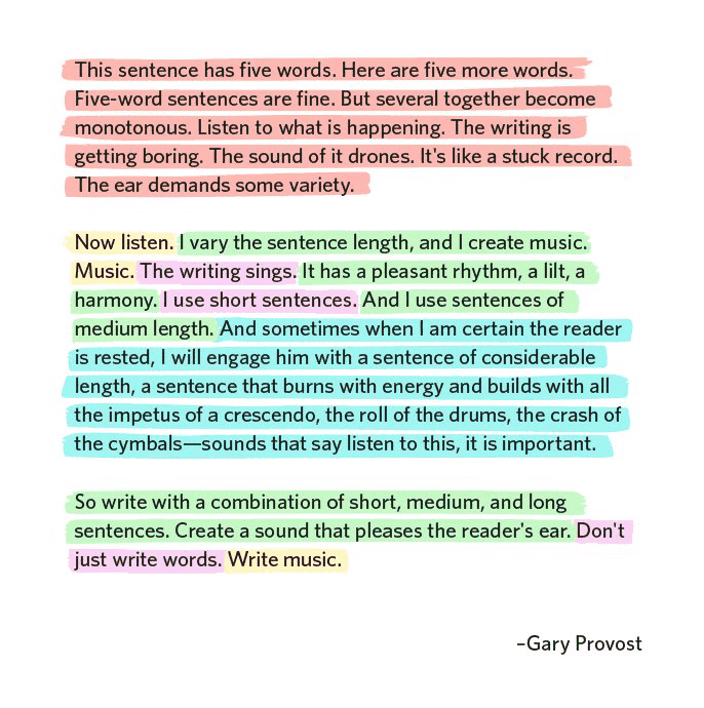
Some of you may remember this viral LinkedIn post quoting American writer Gary Provost.
Clichés and umbrella phrases
Writer’s block is a real thing and sometimes you just need to write something (anything!) so you can move on with your day. So, we fill our pages with clichés in the hope no one will notice. And this might work – people may skim over vague sentences, but they’ll eventually disengage and forget your message.

This email could have been written by literally any company.
There’s nothing wrong with using clichés, but it’s how they are used that’s problematic. Umbrella adjectives like “unparalleled” are not accurate and therefore come off as disingenuous. If you use the same umbrella terminology as other brands, there will be nothing that makes your company unique and identifiable.
This is why Lianna frequently highlights the importance of specificity. Your job as a copywriter is to keep your unique selling point in the reader’s front of mind.
“You might be using what my friend Amy Harrison calls “umbrella phrases” which is where you’re trying to include so many points that you broaden and broaden and broaden until your umbrella covers everything until it’s just meaningless.”
Lianna Patch, Head Puncher at Punchline Conversion Copywriting
TL;DR: High-converting email copywriting tips
So, there you have it – writing email copy that converts isn't that hard if you keep these best practices in mind and let your imagination run free.
Let’s quickly recap our tips to keep in mind when writing your email copy:
Pull copy directly from customer feedback
Lighten up a bit and be conversational
Get creative with call-to-actions
Find “copy-tunities” to be expressive
Send helpful emails between purchase and delivery
Personalize transactional support emails
Avoid the dreaded wall of text
Switch first person to second person perspective
Break up long sentences with punctuation
Be descriptive and highlight USPs
Want to get all of Lianna’s advice and examples? Watch her full session from Email Camp below:
Lianna was one of many memorable speakers from Mailjet’s annual virtual email event, Email Camp. You can watch all the sessions from last year’s Road Trip Edition on our YouTube channel and learn more from Lianna herself on Twitter.
Want to make sure you don’t miss all the great sessions and content at Email Camp 2023? Register below!



